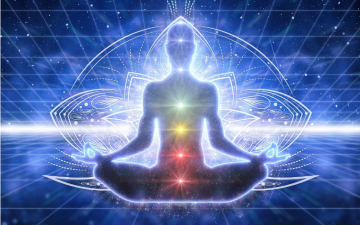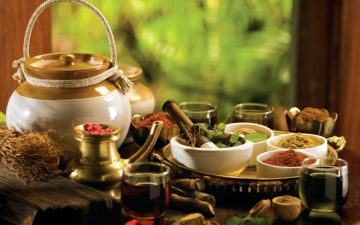The Five Elements in Space and Man
For Ayurveda, the Universe/Cosmos is made up of five elements that are perceived philosophically as great elements. Every material thing is made up of these Ayurveda elements in a certain ratio. This is also the model of Nature and Man, which are micromodels of the Cosmos, and exist under His universal laws.
For man, the proportion of these Ayurveda elements determines both his physiological characteristics and his psychological, mental and spiritual characteristics. With its hardness the EARTH gives the stable shape, the structure. In the human body, these are the dense structures – bones, muscles, and so on. WATER is associated with vitality because of its penetration properties. In the body, these are plasma, digestive secretions, and so on. FIRE is the transformation of matter in various forms. Of the five Ayurveda elements, it is “responsible” for metabolism, digestion. It also relates to intelligence – mental activity and learning. AIR is the movement, in the human body it is associated with heart beating, breathing, work of muscles, and so on. The SPACE or the ether is where the elements are placed /manifestation of the elements/, their boundaries and shape. In the human body these are the cavities – mouth, chest, abdomen and others
For each person, the five Ayurveda elements are given at birth in a unique harmony. They have three basic principles – air, fire and material. This is how the three doshas are obtained. Vata is a combination of air and ether, Pitta is water and fire, Kapha is a combination of water and earth. Their combination determines the body type, and there are three main types – Kapha, Pitta, Vata.
There are, however, different combinations in which there are two predominant doshas. The natural balance between these three forces/biological energies is the ideal state of man, called prakruti. If this equilibrium is maintained, one is healthy, balanced and calm. Deviating from this balance due to improper lifestyle is called vikriti. If the deviations are not large, this state can be defined as “current”. However, if the imbalance gets bigger, the illnesses begin.
 How did the five Ayurveda elements appear?
How did the five Ayurveda elements appear?
Ayurveda is the oldest medicine. As a systematically arranged and completed health science, it has been successfully applied for over 5,000 years. Written testimonies have been preserved in medical treatises since the 1st century BC, but for thousands of years before, the accumulated knowledge was passed down by the Indian sages and the healers of the students verbally. Here it must be noted that Ayurvedic medicine is the result, the manifestation of a philosophical conception for the creation and existence of the world. Not only for Earth and Nature, but for Space as a whole. Therefore, in medical ayurvedic practice, apart from the sciences of man and nature, there is a great deal of knowledge in both astronomy and astrology.
The five elements that created the matter were born from the divine cosmic sound Om /Aum/ in the space. Its vibrations stirred the space and the air appeared. The friction caused by its movement created the heat. The unification of the heated particles led to the appearance of the fire. From its heat particles of the ether melted and the water appeared. By further solidification of some of the liquefied particles, the earth appeared.
The five elements /great elements/ make up the matter and can manifest in different forms. One example can be given with melting the ice, which is on the earthly principle. From the heat it passes into water, it evaporates and goes in the form of air in space.
Although much later, Western civilization also figures out the essential role of elements in human life. Hippocrates did it in the fifth century in Greece, and as it is known, Western civilization perceives him as the father of medicine.
According to him, there are four temperaments, and each corresponds to a certain fluid and element in the body. For the sanguine type, there is express combination of blood and air; the phlegmatic temperament corresponds to mucus and water; cholerics are yellow bile in combination with fire, and in the melancholic type the combination is land and black bile. The fifth of the elements known much earlier in Ayurveda – ether, was added by Aristotle in the western civilization.
 Human characteristics according to the five Ayurveda elements
Human characteristics according to the five Ayurveda elements
The balance of the five elements, given to man at birth, namely Dosha and prakruti, is for life, it does not change. This energy ratio, which is usually somewhat dominated by two Doshas, determines the overall characteristic of man.
In addition to the physical, emotional and spiritual qualities, this balance also determines the predisposition to certain diseases, the diet, which foods and spices are useful, and which are harmful, in what combinations as prevention or appropriate treatment, if necessary.
This, of course, should not be absolutized, because many of the characteristics depend on the vikriti – the current state, which may be sickness. Therefore, it is always advisable to seek Ayurvedic doctor.
Generally, a person with a Vata body type is slim, flexible, but easily tired. Their skin is dry and dark. They cannot stand the cold, the wind, the noise, the heights frighten them, and there is, for example, a problem with an airplane trip. They are bemused and very emotional. They often exaggerate problems, making him restless, their sleep is short, and at the same time, often saturated with dreams. This strong dependence on moods makes them unstable.
The Pitta body type has average physical characteristics such as height and proportions. These people not only resist the cold but also love the winter seasons. They are generally tough, durable. They are intelligent, with combinational and insightful thinking. Practical people who like to dominate, to be leaders. They are very demanding to others as well as to themselves. Even a small mistake can cause a great deal of frustration, even anger, which they are unable to master.
Kapha are large people with massive, heavy bones, prone to obesity. Their skin is cold and pale, the hair is dark. Their nature is calm, friendly, they are usually the “stay-at-home” type, prone to sedentary life, and happy with it. They are slower and are more inert than others.
 The five Ayurveda elements and disease prevention
The five Ayurveda elements and disease prevention
For Ayurveda, the illnesses begin as a result of the disturbed energy balance originally set to each person. Essentially, these are deviations of the proportions of the five Ayurveda elements that are the basis of the doshas and prakruti. These disturbances come from the improper lifestyle that is inconsistent with the needs of the particular type of body.
Increasing the doshas which leads to imbalance is based on the principle that a similar enhances the similar. This means that impacts that have near-to-the-dosha characteristics increase it.
Vata, for example, increases from the cold – food, beverages, climatic conditions – because Vata is generally cold. By the same logic, Pitta must be protected from the sun, heat and humid weather, from hot and hot food, citrus, because it is hot, acidic and damp. Kapha is heavy, cold, oily, so people with this type of body should avoid cold and moisture, heavy and fat foods. Due to their characteristic inertia, inaction is also contraindicated.
Increasing the doshas affects the entire body by stressing the functions of different organs and systems. Of particular importance, however, is the effect on digestion – the digestive fire Agni decreases, the processes of degradation and absorption are affected. This leads to food residues where decay occurs, and poisons are released.
Over time, they penetrate the entire organism, and their accumulation leads to a sticky layer of toxins that damages the body. And physical problems lead to psychological problems, reflecting negatively on emotions and thinking. The increasing of all Vata, Pita, and Kapha in general all affect the degradation and synthesis of substances in the body, consequently strengthening some of the individual processes.
At the same time, the doshas themselves give warning signs about the corresponding disease predispositions. Kapha are prone mainly to lung diseases; Vata are vulnerable to nerve disorders and depressive states. Pitta on the other hand are prone to bile, liver and small intestine diseases.
How to maintain the balance of the five Ayurveda elements
In order to maintain ideal energy balance prakruti, or have a current status that is as close as possible to prakruti, one has to have a certain daily regime. This includes personal hygiene, sleep, work, eating, rest, spiritual activities.
At the same time, living conditions are unstable – climate, seasons, relationships with relatives, friends, and colleagues at work. These external factors also affect one’s state and hence must be controlled.
Vata, due to their sensitivity to external influences and easy fatigue, should avoid the cold and air currents, noisy environments and crowds. At the same time, however, because of their emotionality and frequent anxiety, the feeling of fear of exaggerated problems, it is good not to be alone for a long, to be with their loved ones, especially during the cold, dark seasons. They should also strive to spend as much time as possible in the open, possibly in the wild.
For Pitta the characteristics of the water and fire elements apply. Because of their irritability, it is good for them to try to be more tolerant and to understand others.
It is also good for them to be aware of the “high bars” and the requirements they impose to themselves – to what extent are the material goods they pursue worth the efforts and anguish that harm their entire body. And what is their gain from “leadership” at the expense of suppressing others. It is good to try to be more calmness and balance, and for example, practicing sport at lower temperatures will be very helpful.
The Kapha people should strive to be more active – physically and intellectually. For example, sleeping in is not good for them, they need to get up early and take walks.

 How did the five Ayurveda elements appear?
How did the five Ayurveda elements appear? Human characteristics according to the five Ayurveda elements
Human characteristics according to the five Ayurveda elements The five Ayurveda elements and disease prevention
The five Ayurveda elements and disease prevention
0 Comments